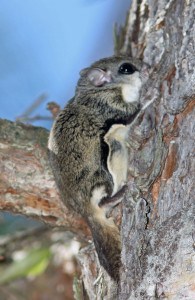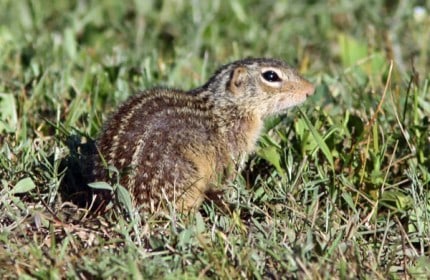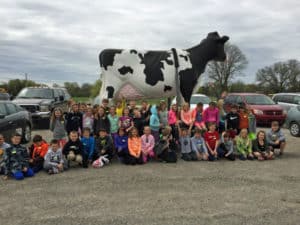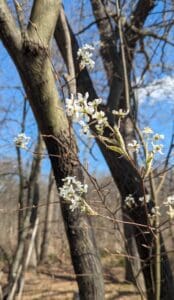

(Chelsea Update would like to thank Tom Hodgson and the Waterloo Natural History Association for the information and photos in this story.)
The tree squirrels with which we are most familiar are the large reddish-brown fox squirrel, the gray squirrel and the smaller red squirrel, all of which are active during the day the year around.
There are three other smaller squirrels that are nearly as common but are either not active all year or not out and about when we are likely to see them. These are the 13-striped ground squirrel, the Eastern chipmunk, and the Southern flying squirrel.
As the 13-lined ground squirrel’s name implies, 13 stripes run the length of its body. Five of the light colored lines break up into a series of spots over the back and rump. Five light and four dark stripes extend to the top of the head and end between the eyes.
This rat-sized squirrel loves sun and warmth, waiting to emerge from his burrow each day until the sun has warmed its environment. On cloudy days, it may not come out at all. Although it loves seeds, half of its diet includes grasshoppers, cutworms, caterpillars, beetles and earthworms. This grassland animal finds lawns, golf courses, cemeteries and athletic fields perfect habitat, and can become a bit of a nuisance when abundant.
Thirteen-lined ground squirrels are true hibernators, retreating to their burrows in October and not emerging until the following May. This is also the mascot for the Minnesota Golden Gophers.
The eastern chipmunk is a little smaller than the ground squirrel. It has two tan and five black stripes down the back, and two tan and two brown stripes on the sides of the face.
Chipmunks are early risers, most active in morning and late afternoon. A chipmunk’s diet includes seeds, nuts, berries, insects, mushrooms and carrion. Although primarily ground dwellers, they will climb trees in the fall to gather nuts and seeds. They are not true hibernators and must cache large amounts of food in their burrows for winter. They may not be seen above ground in winter, but wake up periodically in their burrows to eat. Each burrow even includes an “indoor bathroom.”

Chipmunks are not shy and will often make their burrows near human dwellings. When chipmunks are abundant they can sometimes cause problems by burrowing under patios, retention walls and foundations. They are mostly harmless and fun to watch.
The flying squirrel is just as common as its larger tree squirrel cousins, but because it’s nocturnal it is seldom seen. Its eyes are larger in proportion to its head than other squirrels. This greatly improves night vision. Local bird feeders are often visited by flying squirrels at night without their owners even being aware. They may also seek shelter in bluebird nest boxes in the winter. Sometimes several may be crammed into one nest box to share body heat and create a warmer environment.
The flying squirrel is not a true flier, but a glider. It leaps from a high vantage point and spreads its front and hind legs, stretching folds of loose body skin into a sail. As it approaches a landing point, it raises its tail to change the course of the glide upwards and slow its speed. Upon landing, it will quickly move to the other side of the tree to avoid predators that may have detected and followed them during the glide. The flying squirrel is an agile glider, avoiding obstacles like trees and even making sharp turns in mid-glide.















